Darwin's funeral
Charles Darwin died aged seventy-three at his home, Down House, on 19 April 1882. The news of his death was announced in hundreds of newspapers around the world. Although he and his family intended that he would be buried in St Mary's churchyard in their quiet village of Down, a plan was soon enacted to bury him with great honour in Westminster Abbey, what had come to be seen as the national church. The story has been told many times. Here we will look at some details not covered before. (Some of this is drawn from Darwin: A Companion. The family arrangements are well covered in Correspondence vol. 30, Appendix III.) Darwin Online provides the world's largest collection of primary documents pertaining to Darwin's funeral and obituaries of Darwin.
After his death, Darwin's body was placed in a coffin made according to Darwin's wishes by the village carpenter John Lewis: "I made his coffin just as he wanted it: all rough, just as it left the bench, no polish, no nothing". (A546 Text and F2360 Text) The coffin had a brass plaque which read: "CHARLES ROBERT DARWIN, / Died 19 April, / 1882, / Aged 73 years."
Darwin's neighbour and friend Sir John Lubbock prepared a memorial on 21 April which he signed along with many other MPs suggesting the desirability of a burial in Westminster Abbey. This was sent to the Dean of Westminster, George Granville Bradley. (See LL3:360, 20 signatories; the copy in CUL-DAR215.4c-d Text & image has 27 signatories and that printed in The Life of Sir John Lubbock (1914) has 28 Text).
A writer in The Times noted: "The moment the thought arose, not, apparently, in any single mind, but spontaneously and everywhere, that the body of the great naturalist ought to be buried at Westminster, it was felt that the Abbey needed it more than it needed the Abbey." (A862 Text) The Rev. Frederic Farrar remembered the decision differently. (A1101 Text)
The Dean was then in France but he immediately telegraphed in French "Oui sans aucune hésitation regrette mon absence" (Yes without any hesitation regret my absence). (CUL-DAR215.4c-d Text & image) The Gardeners' Chronicle thought Westminster Abbey "the only place fitting for the reception of such a man". (Text & Image)
After the change to Westminster Abbey was arranged, an expensive coffin was sent to Down by the royal warrant undertakers T. and W. Banting, London. John Lewis would recount for many years "the fitful moonlight that shone through the trees as they brought the coffin late one night to the house" and transferred Darwin's body from the first coffin to the second. (A568 Text) This second coffin 'shell' was enclosed in a lead coffin, this again being enclosed in a coffin of white oak. (For the fate of Darwin's original coffin, and for the first time a photograph of it in the Darwin literature, see Darwin: A Companion.)
Darwin's children William, George and Henrietta took care of the preparations and selected the pall bearers and made lists of relatives, friends, and dignitaries to invite. There were also the ambassadors of France, Germany, Italy, Spain and Russia, and representatives of the universities and learned societies. These lists are transcribed here for the first time:
"Personal Friends Invited (Choir)" CUL-DAR215.3c Text & image
"Family Mourners Choir List" CUL-DAR215.4b Text & image
"Family list" (a draft of above?) CUL-DAR140.5.4 Image PDF
"List of Relatives invited to Jerusalem Chamber" CUL-DAR215.3b Text & image
"List of mourners invited to attend in the Chapter House" CUL-DAR215.3d Image
"List of Persons invited to the funeral of Charles Darwin in Westminster Abbey Ap. 26. '82 (Chapter House)" CUL-DAR215.4a Text & Image
"List of mourners for information of the Press" CUL-DAR140.5.2 Text & image and another copy in CUL-DAR140.5.3 Text & Image
On 24 April the undertakers sent invitations and printed cards of admission to the mourners and pall bearers. The coffin containing Darwin's body was taken the 16 miles to the Abbey on the evening of 25 April in a hearse drawn by four black horses. It was accompanied by Darwin's sons Francis, Leonard and Horace. William and George Darwin joined them at the Abbey and the five sons followed the coffin as it was taken through the cloisters on the south side of the Abbey to be laid out in vigil in the Chapel of St. Faith. (See plan of the Abbey below.) On the east wall a painting of 4th-century martyr St. Faith looked on. Guards stood by the coffin over night by lamplight.
Emma Darwin did not attend the funeral. The mourners gathered at the Abbey on the morning of 26 April for the funeral. Because they were thought to be special or historic, many of the 92x122 mm admission tickets were carefully preserved and survive today, but nothing has been written about them.
There were five types. All have a black mourning border. Four are on white card and have the Dean's seal in black wax as a guarantee of authenticity. One was for the Chapter House (see plan of the Abbey below). Another gave admittance to the Choir (two printed variants of this card exist and two examples without a wax seal have been seen. The Chapter House and Choir tickets have a printing error "12 O'OLOCK" except the rare second variant of the Choir ticket). Another was for the South Transept where invited mourners were seated. Only one example of a North Transept ticket has been seen. The fifth type was for the Jerusalem Chamber and was printed on blue card and does not have the Dean's seal.

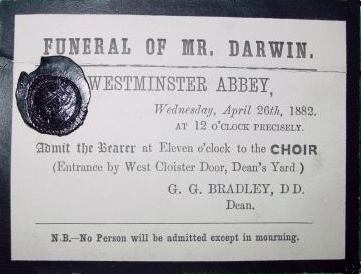
(See also APS-B-D25.120[.2] Image)
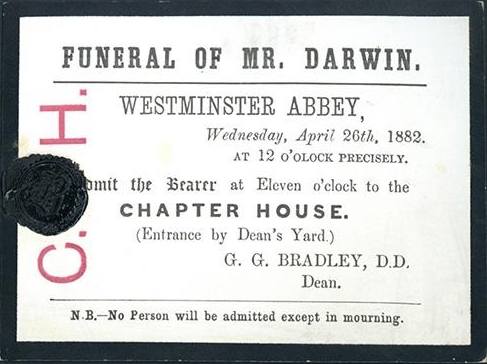
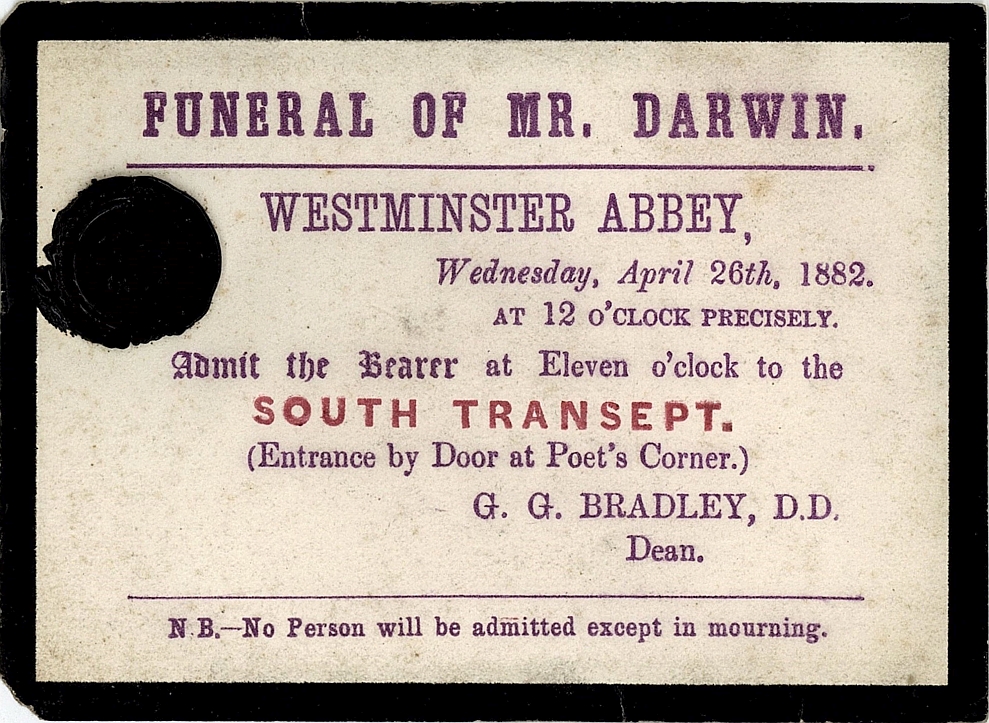
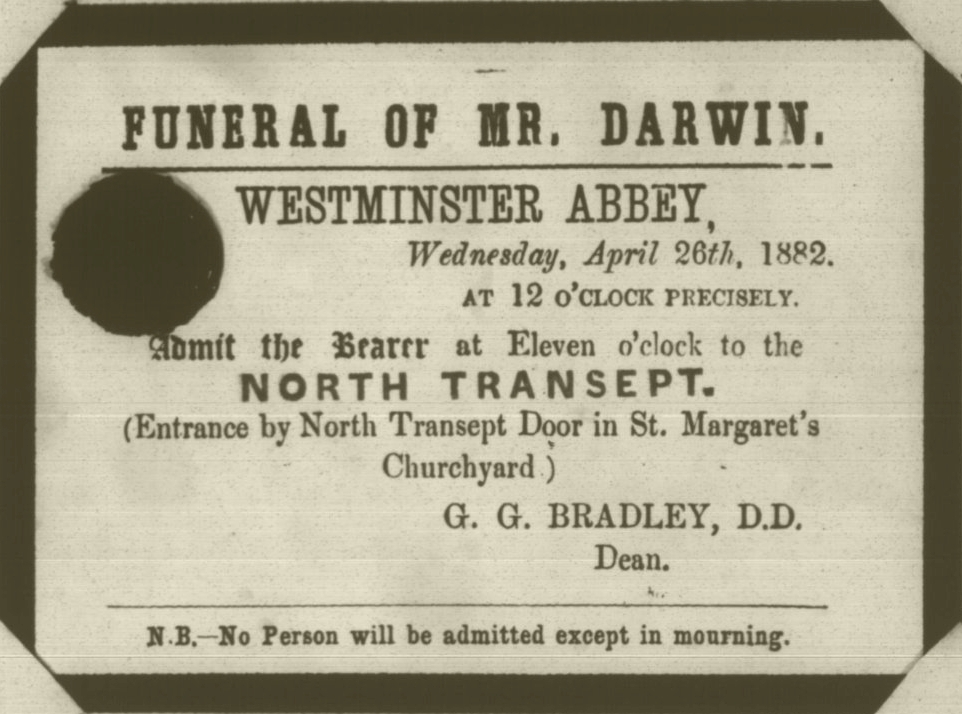
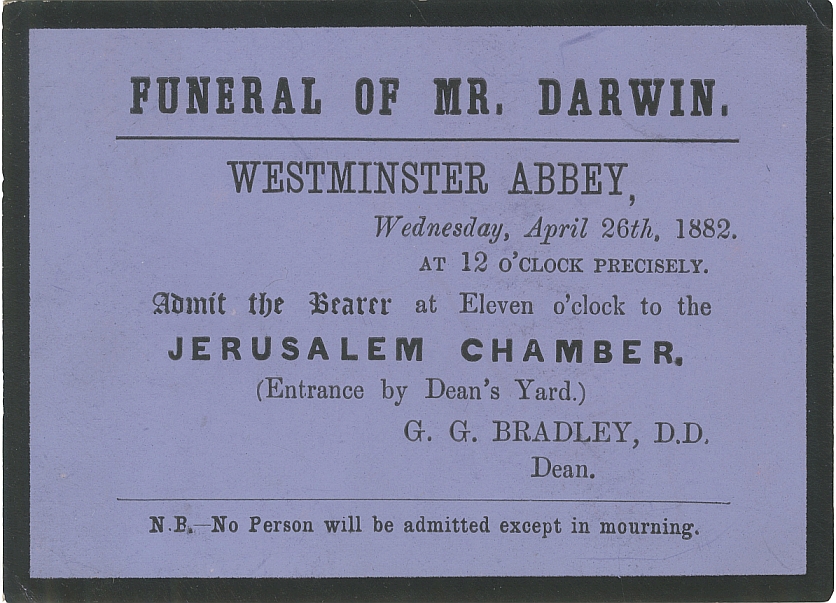
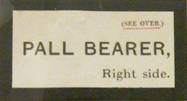
For the first time, all the admission cards for Darwin's funeral presented together.
American journalist G. W. Smalley gave a detailed account of the scene:
Four policemen guarded the closed gateway into Dean's Yard. At the entrance to the cloisters more policemen; at each angle, at each doorway, and at the foot of the stairway leading up to the chapter-house there were both police and officials of the Abbey. In company with a friend I found my way through this thicket of constables a little past eleven this Wednesday morning. Everybody was expected to show his card pretty frequently. Similar precautions were taken at the other entrances to the Abbey. The number of admissions issued was carefully restricted necessarily so, I suppose and a rigid order was maintained in the distribution of visitors throughout nave and aisles and choir. There was much eagerness to be present and the precautions against a rush of the unprivileged public were the usual ones. The hour of the funeral was noon. Holders of chapter-house tickets were expected to arrive not later than half past eleven. At that hour a company of perhaps 200 people had assembled. (A632 Text)
The Abbey's giant bell tolled for almost 15 minutes. The report of the funeral printed in The Times the following day is particularly detailed: "At about 20 minutes to 12 the body was brought out of the Chapel of St. Faith, through the Chapter-house vestibule, into the west cloister, and the procession was formed. The coffin was covered with a black velvet pall edged with white silk". (Text) And there were "numerous wreaths, which, it was observed included not merely the customary combination of milk-white flowers and delicate ferns, but also wreaths of blossoms of many hues, suggestive of the re-awakening of nature in the spring." (Stratford-upon-Avon Herald Text)
"Within the Abbey a large congregation was assembled, filling the seats on the south side of the nave, the seats in the choir and such as were not reserved for the mourners in the transepts, while a large number admitted without tickets stood on the north side of the nave". (The Times Text) Smalley painted the moment vividly: "The passages of the Abbey, never well lighted on the best of days, were obscure with the dull gray haze of an air soaked with moisture. A true London morning - no rain, but the constant menace of rain; no glimpse of sun between the soft masses of cloud; hardly a gleam of daylight through the latticed windows, or within the gray-green enclosure of the cloisters or past the smoke-stained buttresses and pinnacles of the chapel." (Text)

A contemporary plan of Westminster Abbey with places relevant to Darwin's funeral marked or added in red. (Paterson's guide book to England and Wales, 1886)
"Proceeding slowly along the south cloister those heading the procession were met at the west entrance by members of the family and others…" (The Times Text) Smalley wrote: "at the stroke of twelve the head of the column passed through the narrow doorway and into the south aisle." "Canon Prothero having read the opening sentence of the Service for the Burial of the Dead, the choir changed the other processional sentences to the music of Croft ['I am the resurrection'], as the procession moved down the south aisle to the west end of the church and then up the nave into the choir." (The Times Text)
Smalley noted that "the south aisle and the centre of the nave and choir had been kept clear; everywhere else was a throng of humanity, almost all in black. Between these dense masses the procession slowly took its way, along nearly the whole length of the nave, entering the choir through the door of the screen which divides and degrades the church. The coffin was placed beneath the lantern at the steps of the altar; the pall-bearers took seats on either side". Here, in front of the Communion rails, was the first part of the service.
This is the scene depicted in the well-known engraving published in The Graphic on 6 May (A233 Image) but which has never been more precisely described than as in the Abbey:
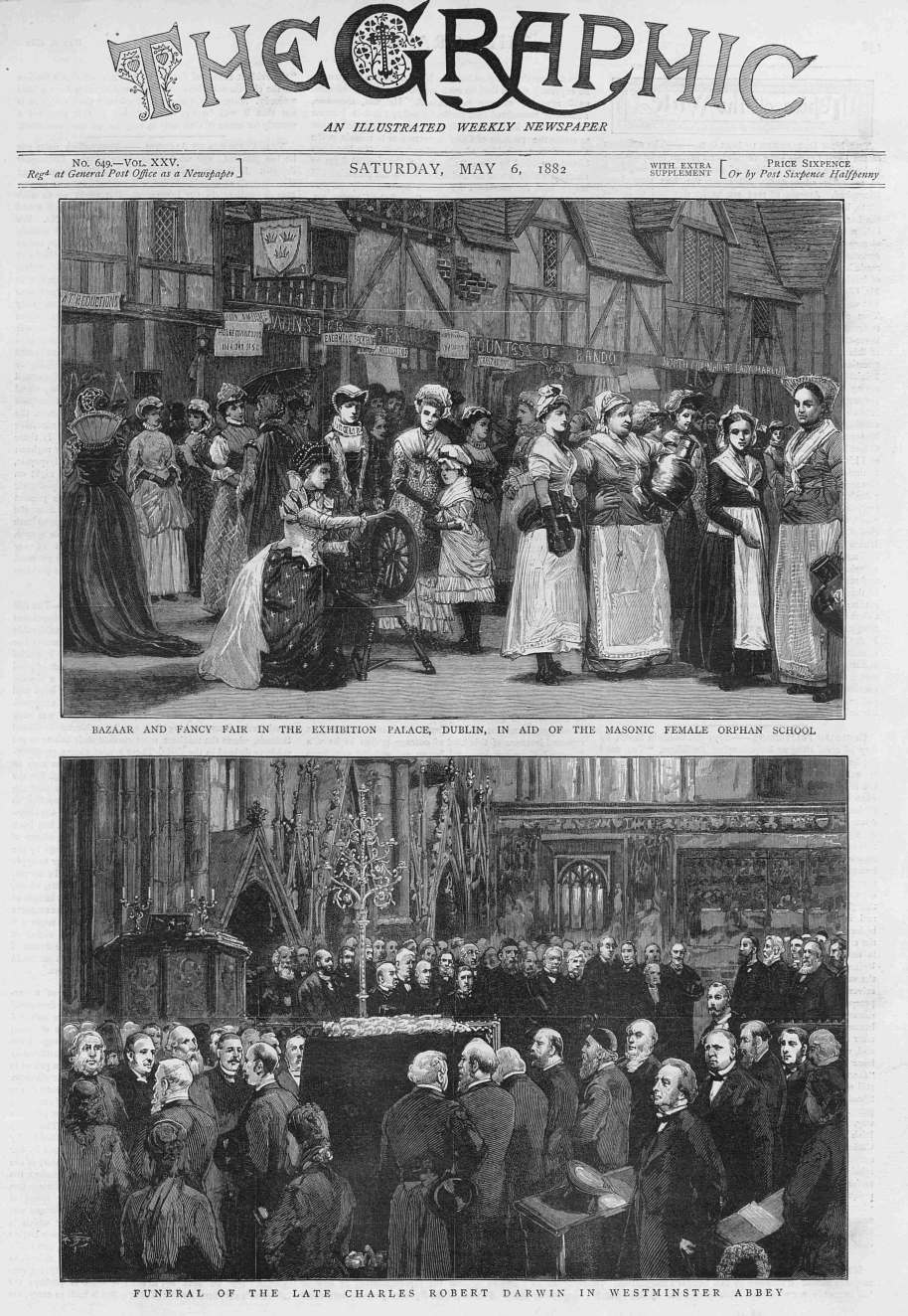
The engraving of Darwin's funeral from the cover of The Graphic on 6 May 1882 - here showing it in its original context (A233 Image, see their earlier obituary: Text)
The 'Order of Procession' was later printed (APS-B-D25.120 Image) with George Darwin recording the exact place of each pall bearer on a copy now in CUL-DAR215.2d Image. He also left a handwritten "Funeral Procession." now in CUL-DAR215.3a Text & image. There is another in CUL-DAR140.5.5 Image PDF
True to the idiosyncratic nature of the family, Darwin's eldest son and chief mourner, William, felt the cold on his bald head so balanced his black gloves there to keep warm. The organist J. F. Bridge played "Beethoven's Funeral March and then a more plaintive march by Franz Schubert in B minor, while the mourners proceeded to the grave, and the rest of the service was impressively read by Canon Prothero, the choir singing their part to Croft and Purcell's music." (The Times Text)
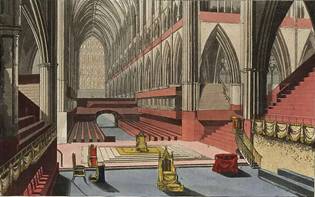
An 1821 engraving of the interior of Westminster Abbey
The Times account continued: "The Psalms were chanted to Purcell's music, and after the Lesson, which was read by Canon Duckworth, an anthem composed for the occasion by Mr. Bridge was sung to the words from the Book of Proverbs, 'Happy is the man that findeth wisdom and getteth understanding. She is more precious than rubies, and all the things thou canst desire are not to be compared unto her. Length of days is in her right hand, and in her left hand riches and honour. Her ways are ways of pleasantness, and all her paths are peace.' The soft and subdued ending of the composition, which was sung with much feeling by the choir, prepared the mind for the last sad duty that remained to be performed." (The Times Text) Bridge's anthem was later printed. (APS-B-D25.120[.3] Text & image; CUL-DAR215.4e Image and CUL-DAR140.5.10-11 Image PDF)
The coffin was then solemnly taken to the seven-foot-deep grave beneath the floor of the Abbey and right next to that of astronomer Sir John Herschel (1792-1871). Handel's anthem 'His body is buried in peace, but his name liveth evermore' was sung. Then Canon Prothero pronounced the Benediction: "The grace of our Lord Jesus Christ, and the love of God, and the fellowship of the Holy Ghost, be with us all evermore. Amen." "The mourners left, and the public were then allowed to pass round the grave. The inscription on the plate of the white, unpolished oak coffin read, "Charles Robert Darwin. Born February 12, 1809. Died April 19th, 1882." (The Times Text) The following Sunday a funeral sermon was preached in the Abbey by the Bishop of Carlisle.
Along with countless other newspapers, The Spectator declared that "England has lost the most original, as well as far the most celebrated, of modern men of science,—the one man whom European Science would, with one voice, probably agree to consider as the most eminent scientific writer and thinker of the present century." (A1216 Text)
Darwin family documents
"Funeral procession" (Chapter House) CUL-DAR215.3a Text & image
"List of Relatives invited to Jerusalem Chamber" CUL-DAR215.3b Text & image
"Personal Friends Invited (Choir)" CUL-DAR215.3c Text & images
"List of persons forming procession (Chapter House) CUL-DAR215.4a Text & image
"Family Mourners Choir List" CUL-DAR215.4b Text & image
Printed
"The funeral of the late Mr. Darwin, List of mourners invited to attend in the Chapter House." Copy in CUL-DAR215.3d marked "very erroneous GHD" by George Darwin. Indeed, many names there are not in this manuscript list (CUL-DAR215.3d) and vice versa. Another copy is in CUL-DAR140.5.1 Image PDF.
"Order of Procession" CUL-DAR215.2d Image
Darwin Archive folders
CUL-DAR215: Darwin's funeral, obituaries & related correspondence. 345 images Browse
Itemized (Almost all transcribed here)
CUL-DAR138.1: Press-cuttings on Darwin's death & funeral. Mostly French newspapers. 236 images Browse Itemized
CUL-DAR140.5: Material on Darwin's death & funeral. 157 images Browse Itemized
Darwin Online contains the largest collection of obituaries of Charles Darwin ever published- over 260, in 11 languages (Czech, Dutch, English, Finnish, French, German, Italian, Norwegian, Portuguese, Spanish and Swedish), 200 of them transcribed. There are several other accounts of Darwin's funeral in this collection.
Full list of obituaries (click here)
A detailed article about Darwin's burial is: J. R. Moore, 1982. Charles Darwin lies in Westminster Abbey. Biological Journal of the Linnean Society, 17,1 (February): 97-113.
RN3





